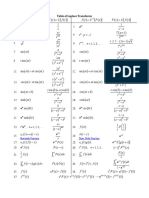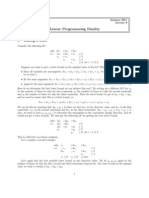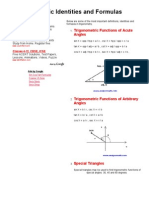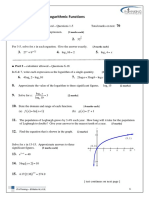0 ratings0% found this document useful (0 votes)
47 viewsLinear Programming I - Part 3
This document discusses duality in linear programming problems (LPPs). It explains that the primal and dual LPPs are related through transformations of the objective functions and constraints. The optimal solutions to the primal and dual problems are related through complementary slackness conditions. Examples are provided to demonstrate how to derive the dual problem from the primal and vice versa.
Uploaded by
Trisha elejordeCopyright
© © All Rights Reserved
Available Formats
Download as PDF, TXT or read online on Scribd
0 ratings0% found this document useful (0 votes)
47 viewsLinear Programming I - Part 3
This document discusses duality in linear programming problems (LPPs). It explains that the primal and dual LPPs are related through transformations of the objective functions and constraints. The optimal solutions to the primal and dual problems are related through complementary slackness conditions. Examples are provided to demonstrate how to derive the dual problem from the primal and vice versa.
Uploaded by
Trisha elejordeCopyright
© © All Rights Reserved
Available Formats
Download as PDF, TXT or read online on Scribd
You are on page 1/ 15
DUALITY
LINEAR PROGRAMMING PROBLEM
Duality in Linear Programming
The pair of LPPs:
Minimize c1 x1+ c2 x2 + + cn xn
subject to
a11 x1 + a12 x2 + + a1n xn ≥ b1
a21 x1 + a22 x2 + + a2 n xn ≥ b2
am1 x1 + am 2 x2 + + amn xn ≥ bm
x1 ≥ 0, , xn ≥ 0
are dual to each other.
The original problem, called the primal problem, is
transformed into a dual problem, by the following
procedures:
a) Change “maximize” to “minimize” and vice-versa.
b) Except for the nonnegativity restrictions, the inequality signs
in the primal constraints are reversed in the dual constraints.
c) The coefficient matrix of the dual constraints is the
transpose of the coefficient matrix of the primal constraints.
d) The row vector of coefficients in the primal objective
function is the column vector of constants in the dual
constraints.
Examples:
a) Max 45y1 + 55y2
subj. to
6y1 + 4y2 ≤ 120 6 4
3y1 + 10y2 ≤ 180 3 10
y1, y2 ≥ 0
The dual is given by:
Min 120 x1 + 180 x2
subj. to
6x1 + 3x2 ≥ 45 6 3
4 10
4x1 + 10x2 ≥ 55
x1, x2 ≥ 0
b) Min 2x1 + 10x2
subj. to
2x1 + x2 ≤ 6
5x1 + 4x2 ≥ 20
x1, x2 ≥ 0
Must be written in general form:
Min 2x1 + 10x2
subj. to
-2x1 - x2 ≥ -6
5x1 + 4x2 ≥ 20
x1, x2 ≥ 0
The dual is
Max -6y1 + 20y2
subj. to
-2y1 + 5y2 ≤ 2
-y1 + 4y2 ≤ 10
y1, y2 ≥ 0
Thm. If x is primal feasible and y is dual feasible then
VOF(x) ≥ VOF (y), i.e., the minimand can never fall below the
maximand.
Thm. If x* is primal feasible and y* is dual feasible, and
VOF (x*) = VOF(y*), then x* and y* are optimal solutions.
Thm. If the primal is unbounded, then the dual is
infeasible.
Thm. (Complementary Slackness) If x* and y* are
primal and dual optimal, respectively, then
(i) if yi* > 0, then ti* = 0 and if xj * > 0 then sj* = 0;
(ii) if ti * > 0, then yi * = 0 and if sj* > 0 then xj* = 0,
where t* and s* are vectors of surplus and slack
variables, respectively.
Minimize c1 x1+ c2 x2 + + cn xn Maximize b1 y1+ b2 y2 + + bm ym
subject to subject to
a11 x1 + a12 x2 + + a1n xn − t1 = b1 a11 y1 + a21 y2 + + an1 ym + s1 = c1
a21 x1 + a22 x2 + + a2 n xn − t 2 = b2 a12 y1 + a22 y2 + + an 2 ym + s 2 = c2
am1 x1 + am 2 x2 + + amn xn − tm = bm a1n y1 + a2 m y2 + + anm ym + sn ≤ cn
x1 ≥ 0, , xn ≥ 0 y1 ≥ 0, , ym ≥ 0
Thm. (Complementary Slackness) If x* and y* are
primal and dual optimal, respectively, then
(i) if yi* > 0, then ti* = 0 and if xj * > 0 then sj* = 0;
(ii) if ti * > 0, then yi * = 0 and if sj* > 0 then xj* = 0,
where t* and s* are vectors of surplus and slack
variables, respectively.
There is no implication if:
(i) if yi* = 0 or xj* = 0.
(ii) if ti * = 0 or sj* = 0.
Recall JAMES
James produces two commodities, y1 and y2. These two
products are processed through 2 machines. Maximum
hours available are 120 and 180 for machines 1 and 2,
respectively. Profit is P45 for y1 and P55 for y2. Determine
the optimal y1 and y2 that should be manufactured in order
to maximize profit.
Determining the dual solution from the primal solutions:
Max. 45y1 + 55y2
subj. to y1* > 0 implies t1* = 0.
6y1 + 4y2 ≤ 120 y2* > 0 implies t2* = 0
3y1 + 10y2 ≤ 180
y1, y2 ≥ 0
y1* = 10; y2* = 15; VOF (y) = 1,275
Min 120 x1 + 180 x2
subj. to
6x1 + 3x2 ≥ 45 6x1 + 3x2 = 45
4x1 + 10 x2 ≥ 55 4x1 + 10 x2 = 55
x1, x2 ≥ 0
x1* = 95/16 or 5.9375 ; x2* = 3.125; VOF (x) = 1,275
Determining the dual solution from the primal solutions:
Max. y1 - y2
subj. to y1* > 0 implies t1* = 0.
-4y1 + 3y2 ≤ 3
y1 - y2 ≤ 3
y1, y2 ≥ 0
y1* = 3; y2* = 0; VOF (y) = 3
Min 3x1 + 3x2 3x1 + 3x2 = 3
subj. to
-4x1 + x2 ≥ 1 -4x1 + x2 = 1
3x1 - x2 ≥ -1
x1, x2 ≥ 0
x1* = 0; x2* = 1; VOF (x) = 3
Example 3 : BOURNE
Bourne manufactures tables (y1), chairs (y2) and
benches (y3) and derives a per unit profit of P6, P8 and
P7, respectively. Only two resources are consumed in
manufacturing: wood (300 board feet in inventory) and
labor (110 hours available). Bourne uses 30 board ft to
produce a table; 20 board ft for a chair and 25 board ft
for a bench. He also uses 5 hours of labor to produce
a table, 10 hours for a chair, and 7 hours for a bench.
Max π = 6y1 + 8y2 + 7y3
subject to
30y1 + 20y2 + 25y3 ≤ 300
5y1 + 10y2 + 7y3 ≤ 110
y1, y2 ≥ 0
Min C = 300x1 + 110x2
subject to
30x1 + 5x2 ≥ 6
20x1 + 10x2 ≥ 8
25x1 + 7x2 ≥ 7
x1, x2 ≥ 0
Max π = 6y1 + 8y2 + 7y3 6y1 + 8y2 + 7y3 = 98.1818
subject to
30y1 + 20y2 + 25y3 ≤ 300 30y1 + 20y2 + 25y3 = 300
5y1 + 10y2 + 7y3 ≤ 110 5y1 + 10y2 + 7y3 = 110
y1, y2 ≥ 0
y1* = 0; y2* = 5.9091; y3* = 7.2727
Min C = 300x1 + 110x2
subject to
30x1 + 5x2 ≥ 6 x1* > 0 implies s1* = 0.
20x1 + 10x2 ≥ 8 x2* > 0 implies s2* = 0
25x1 + 7x2 ≥ 7
x1, x2 ≥ 0
x1* = 7/55 or 0.1273; x2* = 6/11 or 0.5455 ; VOF (x) = 98.1818
Exercise
Solve the following linear programming problem by
solving the dual problem:
min G = 6y1 + 20y2 + 3y3 + 20y4
subject to
3y1 + 6y2 - y3 + 2y4 ≥ 4
-4y1 + 2y2 + y3 + 5y4 ≥ 2
yi ≥ 0 i = 1, ...., 4
Answer: x1=2.308; x2=3.077; VOF = 15.385
y1 = 0, y2 = 0.615, y3 = 0, y4 = 0.154
You might also like
- Settlement Templating Language (STL) : Release 1.2No ratings yetSettlement Templating Language (STL) : Release 1.223 pages
- Teaching Mathematics Foundations To Middle Years - (15 Place Value F-4) PDF100% (1)Teaching Mathematics Foundations To Middle Years - (15 Place Value F-4) PDF29 pages
- Managerial Decision Making and Mathematical Optimization Problems - 22jan2019No ratings yetManagerial Decision Making and Mathematical Optimization Problems - 22jan201910 pages
- Chapter 4 LP Duality and Sensitivity AnalysisNo ratings yetChapter 4 LP Duality and Sensitivity Analysis27 pages
- Dual Problems and Duality Theorems: I Ij INo ratings yetDual Problems and Duality Theorems: I Ij I4 pages
- Chap6 Duality Theory and Sensitivity Analysis: College of Management, NCTU Operation Research I Fall, 2008No ratings yetChap6 Duality Theory and Sensitivity Analysis: College of Management, NCTU Operation Research I Fall, 200826 pages
- Mathematical Programming Solutions To Examples 3No ratings yetMathematical Programming Solutions To Examples 36 pages
- For Every Linear Programming Problem Whether Maximization or Minimization Has Associated With It Another Mirror Image Problem Based On Same DataNo ratings yetFor Every Linear Programming Problem Whether Maximization or Minimization Has Associated With It Another Mirror Image Problem Based On Same Data21 pages
- Sensitivity Analysis and Duality of LP ProblemsNo ratings yetSensitivity Analysis and Duality of LP Problems24 pages
- Sensitivity Analysis and Duality of LP Problems100% (1)Sensitivity Analysis and Duality of LP Problems29 pages
- Duality Theory: Let Us Consider The Following L.P.PNo ratings yetDuality Theory: Let Us Consider The Following L.P.P6 pages
- Mathematical Programming Solutions To Examples 4No ratings yetMathematical Programming Solutions To Examples 45 pages
- Primal-Dual Problems 1. When You Solve A Linear Program in Standard Form With The Simplex Algorithm, YouNo ratings yetPrimal-Dual Problems 1. When You Solve A Linear Program in Standard Form With The Simplex Algorithm, You7 pages
- INDE6372: LECTURE 10 Midterm Review: Jiming Peng Department of Industrial Engineering University of HoustonNo ratings yetINDE6372: LECTURE 10 Midterm Review: Jiming Peng Department of Industrial Engineering University of Houston30 pages
- Chapter 1 Linear Programming 1.1 Transportation of CommoditiesNo ratings yetChapter 1 Linear Programming 1.1 Transportation of Commodities35 pages
- MATHEMATICAL ECONOMICS Lecture5 15445290No ratings yetMATHEMATICAL ECONOMICS Lecture5 1544529028 pages
- Lecture Notes 4: Duality: Vincent ConitzerNo ratings yetLecture Notes 4: Duality: Vincent Conitzer4 pages
- Chapter Two Part V Duality and Sensitivity AnalysisNo ratings yetChapter Two Part V Duality and Sensitivity Analysis75 pages
- Factoring and Algebra - A Selection of Classic Mathematical Articles Containing Examples and Exercises on the Subject of Algebra (Mathematics Series)From EverandFactoring and Algebra - A Selection of Classic Mathematical Articles Containing Examples and Exercises on the Subject of Algebra (Mathematics Series)No ratings yet
- 18: Shortest Paths IV - Speeding Up Dijkstra: (Stop If U T!)No ratings yet18: Shortest Paths IV - Speeding Up Dijkstra: (Stop If U T!)7 pages
- Download Full Binomial ideals Herzog PDF All Chapters100% (3)Download Full Binomial ideals Herzog PDF All Chapters62 pages
- (New ICMI Studies) R. Sutherland, Teresa Rojano, Alan Bell, Romulo Lins - Perspectives on School Algebra -Springer Netherlands (2000)No ratings yet(New ICMI Studies) R. Sutherland, Teresa Rojano, Alan Bell, Romulo Lins - Perspectives on School Algebra -Springer Netherlands (2000)287 pages
- 04 Section3 Mass Modelling Input 012904No ratings yet04 Section3 Mass Modelling Input 01290416 pages
- Lecture Plan Exercise Plan: Control Systems Theory and DesignNo ratings yetLecture Plan Exercise Plan: Control Systems Theory and Design1 page
- (Ebook) Groups, graphs and trees: An introduction to the geometry of infinite groups by John Meier ISBN 9780511424427, 9780521895453, 0511424426, 0521895456 pdf downloadNo ratings yet(Ebook) Groups, graphs and trees: An introduction to the geometry of infinite groups by John Meier ISBN 9780511424427, 9780521895453, 0511424426, 0521895456 pdf download57 pages
- Reviewed Competency Based Curriculum For Fashion Design Level 6No ratings yetReviewed Competency Based Curriculum For Fashion Design Level 6111 pages
- 1.4 Write The Equation of A Line in Slope-Intercept Form Given Two PointsNo ratings yet1.4 Write The Equation of A Line in Slope-Intercept Form Given Two Points2 pages
- January 2014 QP - Paper 2F Edexcel Maths (A) IGCSENo ratings yetJanuary 2014 QP - Paper 2F Edexcel Maths (A) IGCSE20 pages
- Download ebooks file Geometry for Programmers MEAP V03 Oleksandr Kaleniuk all chapters100% (4)Download ebooks file Geometry for Programmers MEAP V03 Oleksandr Kaleniuk all chapters37 pages
- Course Name: Discrete Mathematics For IT: Annexure CD - 01'No ratings yetCourse Name: Discrete Mathematics For IT: Annexure CD - 01'5 pages
- Test - Exponential & Logarithmic FunctionsNo ratings yetTest - Exponential & Logarithmic Functions2 pages

























































































